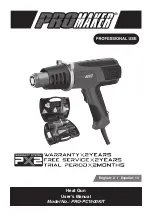
10
| English
u
If devices are provided for the connection of dust ex-
traction and collection facilities, ensure these are con-
nected and properly used.
Use of dust collection can re-
duce dust-related hazards.
u
Do not let familiarity gained from frequent use of tools
allow you to become complacent and ignore tool
safety principles.
A careless action can cause severe in-
jury within a fraction of a second.
Power tool use and care
u
Do not force the power tool. Use the correct power
tool for your application.
The correct power tool will do
the job better and safer at the rate for which it was de-
signed.
u
Do not use the power tool if the switch does not turn it
on and off.
Any power tool that cannot be controlled
with the switch is dangerous and must be repaired.
u
Disconnect the plug from the power source and/or re-
move the battery pack, if detachable, from the power
tool before making any adjustments, changing ac-
cessories, or storing power tools.
Such preventive
safety measures reduce the risk of starting the power tool
accidentally.
u
Store idle power tools out of the reach of children and
do not allow persons unfamiliar with the power tool or
these instructions to operate the power tool.
Power
tools are dangerous in the hands of untrained users.
u
Maintain power tools and accessories. Check for mis-
alignment or binding of moving parts, breakage of
parts and any other condition that may affect the
power tool’s operation. If damaged, have the power
tool repaired before use.
Many accidents are caused by
poorly maintained power tools.
u
Keep cutting tools sharp and clean.
Properly main-
tained cutting tools with sharp cutting edges are less
likely to bind and are easier to control.
u
Use the power tool, accessories and tool bits etc. in
accordance with these instructions, taking into ac-
count the working conditions and the work to be per-
formed.
Use of the power tool for operations different
from those intended could result in a hazardous situation.
u
Keep handles and grasping surfaces dry, clean and
free from oil and grease.
Slippery handles and grasping
surfaces do not allow for safe handling and control of the
tool in unexpected situations.
Battery tool use and care
u
Recharge only with the charger specified by the manu-
facturer.
A charger that is suitable for one type of bat-
tery pack may create a risk of fire when used with another
battery pack.
u
Use power tools only with specifically designated bat-
tery packs.
Use of any other battery packs may create a
risk of injury and fire.
u
When battery pack is not in use, keep it away from
other metal objects, like paper clips, coins, keys,
nails, screws or other small metal objects, that can
make a connection from one terminal to another.
Shorting the battery terminals together may cause burns
or a fire.
u
Under abusive conditions, liquid may be ejected from
the battery; avoid contact. If contact accidentally oc-
curs, flush with water. If liquid contacts eyes, addi-
tionally seek medical help.
Liquid ejected from the bat-
tery may cause irritation or burns.
u
Do not use a battery pack or tool that is damaged or
modified.
Damaged or modified batteries may exhibit
unpredictable behaviour resulting in fire, explosion or risk
of injury.
u
Do not expose a battery pack or tool to fire or excess-
ive temperature.
Exposure to fire or temperature above
130°C may cause explosion.
u
Follow all charging instructions and do not charge the
battery pack or tool outside the temperature range
specified in the instructions.
Charging improperly or at
temperatures outside the specified range may damage
the battery and increase the risk of fire.
Service
u
Have your power tool serviced by a qualified repair
person using only identical replacement parts.
This
will ensure that the safety of the power tool is maintained.
u
Never service damaged battery packs.
Service of bat-
tery packs should only be performed by the manufacturer
or authorized service providers.
Safety instructions for metal shears
u
This power tool is not suitable for bench-mounted use.
It must not be clamped into a vice or fastened to a work-
bench, for example.
u
Only carry out work with a fitted chip deflector. Make
sure that the chip deflector is not damaged or bent out
of shape.
Working without a chip deflector or with a dam-
aged chip deflector poses a risk of injury. Have a dam-
aged chip deflector replaced immediately by an author-
ised after-sales service centre for
Bosch
power tools.
u
Wear protective gloves during work. Make sure that
cut sheet parts are not bent towards your body.
Sharp
burrs develop on cut sheets; these can cause injury.
When necessary and while wearing gloves, press bending
sheet parts away from your body.
u
In case of damage and improper use of the battery, va-
pours may be emitted. The battery can set alight or ex-
plode.
Ensure the area is well ventilated and seek medical
attention should you experience any adverse effects. The
vapours may irritate the respiratory system.
u
Do not open the battery.
There is a risk of short-circuit-
ing.
u
The battery can be damaged by pointed objects such
as nails or screwdrivers or by force applied externally.
An internal short circuit may occur, causing the battery to
burn, smoke, explode or overheat.
1 609 92A 6N5 | (10.06.2021)
Bosch Power Tools











































